A Private Tour today with a regular client, with some particular target birds we wanted to see. Unfortunately, there was some intermittent and patchy thick mist along the coast for a time today, but by trying to dodge it and making the most of the sunnier spells, we still managed to amass a great tally of birds for the day.
We met in Wells and made our way west along the coast. There were lots of Blackbirds and a few Redwings in the hedges as drove along, feeding on the berries. Our first destination for the day was Titchwell.
As we walked out along the main path, a Water Rail ran along the bottom of the ditch beside us, a nice way to start the day. The grazing meadow pool had been flooded by the high tide, which was just receding, so there were no birds that we could see. It was still a bit misty, so we thought we would have a look on the way back. As we passed, a juvenile Peregrine flew in over the saltmarsh and headed off towards Thornham.
 Sunrise – over Island Hide and the reedbed
Sunrise – over Island Hide and the reedbed
There was a lovely hazy sunrise looking out over the reedbed as we headed out to the freshmarsh. The water level is very high still at the moment, but still there were lots of Lapwings on here. They were very nervous and kept flying round calling. Twelve Avocets, bravely hanging on through the winter, were not so fidgety and stayed mostly asleep in the shallows. There was a nice selection of wildfowl on here as usual – Wigeon, Gadwall, Teal, Mallard, Shoveler and three Pintail, a drake and two females.
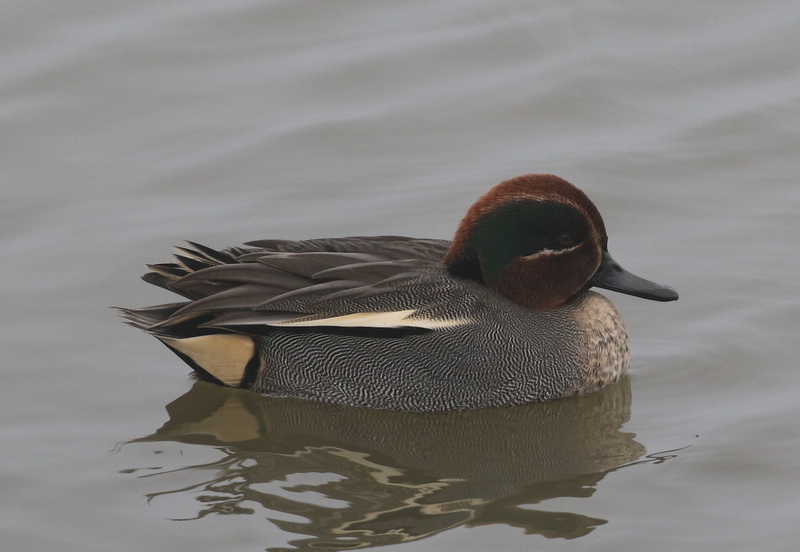 Teal – lots on the freshmarsh, the drakes are looking very smart now
Teal – lots on the freshmarsh, the drakes are looking very smart now
Volunteer Marsh was still under water, so we hurried past to the tidal pools beyond. There were lots of waders on here, roosting over the high tide. A line of godwits consisted of a mixture of both Black-tailed and Bar-tailed Godwits, a nice comparison side by side. A single much smaller Knot was in with them. Further over, a couple of Grey Plover were roosting with a little mixed group of Turnstones and Dunlin.
Over at the back, we could see a flock of sleeping Common Redshank and nearby were several noticeably paler birds. Two Greenshank were roosting up on the mud behind. Another paler bird was in the water just behind the line of duller grey Common Redshank, and through the scope we could confirm it was a single Spotted Redshank. When looked back again later, two more Spotted Redshanks had appeared with it.
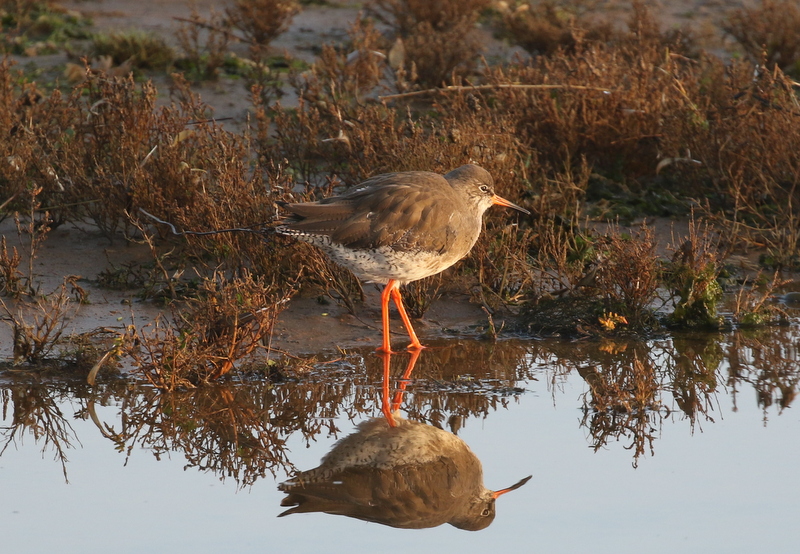 Common Redshank – its legs shining in the morning sunshine
Common Redshank – its legs shining in the morning sunshine
The main point of our visit here today was to have a look at the sea and our primary target was Long-tailed Duck. There have been up to 70 here for the last couple of weeks, an unprecedented number in recent years. We were not disappointed. As we climbed up into the dunes, we could see that the sea was alive with ducks, including lots of Long-tailed Ducks. Amazing!
 Long-tailed Ducks – around 70 were on the sea here today (these from yesterday)
Long-tailed Ducks – around 70 were on the sea here today (these from yesterday)
We managed to get onto one or two adult male Long-tailed Ducks – stunning birds with their incredibly long and narrow tail feathers. The drakes are much whiter than the females and immature birds which make up the majority of the birds here. They also have a striking pink saddle over the bill, and we could even make that out on them as it glowed in the sunshine.
Apart from the Long-tailed Ducks, there were hundreds of Common Scoter offshore. In with them, there are also an impressive number of Velvet Scoter too, many more than we usually get here at this time of year. We got some great views of them too today, with the sea flat and calm.
The rest of the gathering was made up of five Scaup, plus several Eider, Red-breasted Merganser and Goldeneye. It is amazing to watch all these ducks out on the sea at the moment. Many of them are diving for shellfish and we saw several coming up with large razorshells in their bills. The staff and volunteers on the reserve were doing a wildfowl count while we were there today and their final tallies were impressive, including 73 Long-tailed Ducks and 46 Velvet Scoter! We just enjoyed watching them all.
As well as the ducks, there were other birds on the sea too. A Slavonian Grebe was diving in with the ducks and several Great Crested Grebes were offshore too. A lone Guillemot drifted past. There were several divers too, though they were mostly a bit more distant and harder to see on the edge of the mist. There were three Great Northern Divers, and thankfully one of them appeared in front of the ducks straight out from us, giving us a great look at it.
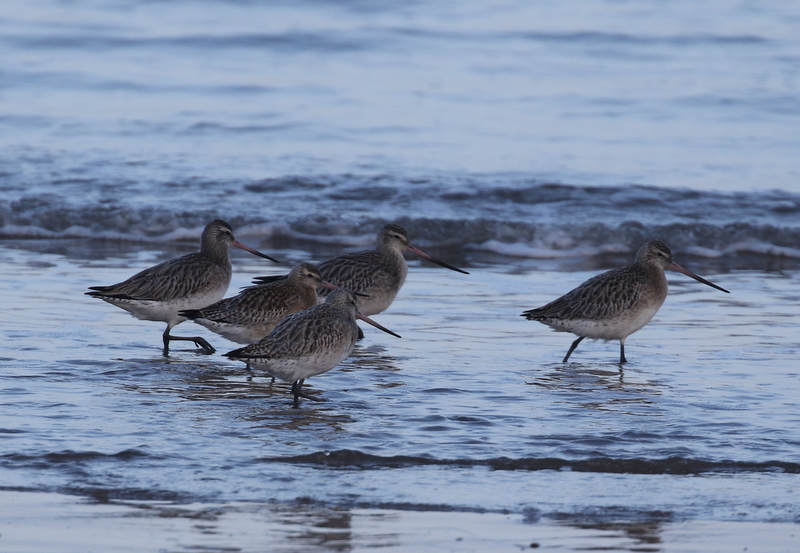 Bar-tailed Godwits – gathered on the shore as the tide started to go out
Bar-tailed Godwits – gathered on the shore as the tide started to go out
The only Black-throated Diver today was quite a long way out and further to the west from where we were standing, so we decided to walk along the beach to try to get everyone onto it. There were more waders on the shore now, with the tide starting to go out, including a nice flock of Bar-tailed Godwits.
We had just positioned ourselves to start scanning the sea again, level with where we thought the Black-throated Diver should be, when the fog descended around us, blowing in over the saltmarsh behind us. We waited here a few minutes to see if it would clear. A couple of times, the sun looked like it would break through, but each time it disappeared again into the mists and our hopes were dashed. We amused ourselves watching several Turnstones and Sanderling picking along the pile of razorshells washed up along the high tide line. Finally, we came to the conclusion it wasn’t going to clear any time soon, so reluctantly we started to walk back.
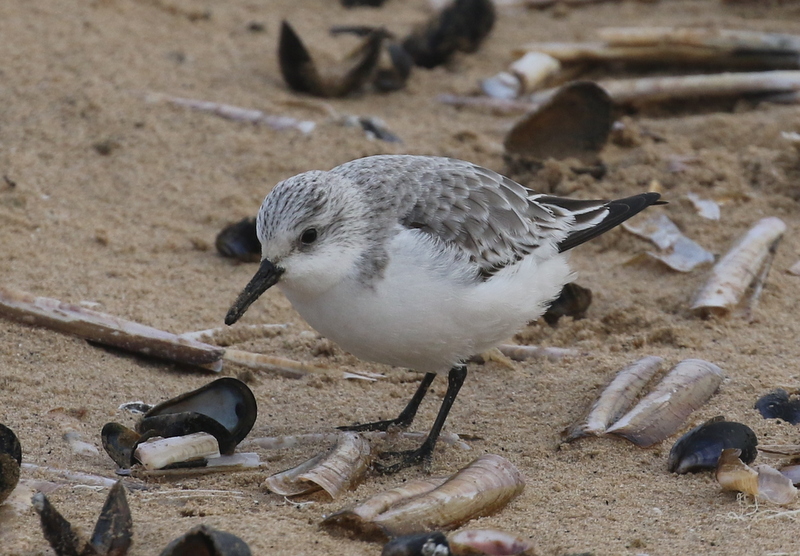 Sanderling – feeding on the piles of shells along the high tide line
Sanderling – feeding on the piles of shells along the high tide line
On the way back, we stopped briefly in the Parrinder Hide. From here, you couldn’t even see across the freshmarsh today. A nice Common Snipe feeding on the bank just outside the hide was some compensation.
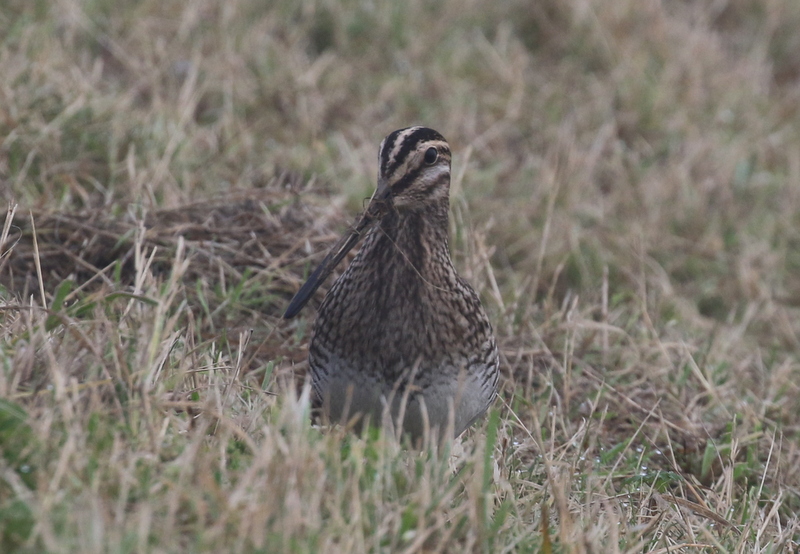 Common Snipe – feeding on the bank outside Parrinder Hide
Common Snipe – feeding on the bank outside Parrinder Hide
The grazing meadow pool was now hidden in thick fog. So much for our hoped for better look on the way back! We had a quick look in the alders by the main path and visitor centre but couldn’t find any redpolls here today. We did find a single Siskin feeding in amongst the Goldfinches up in the tops of the trees.
While we waited for the fog to clear, we decided to have a quick look round in Thornham Harbour. A single Greenshank was feeding in the bottom of the harbour channel by the car park, along with a Redshank, a Curlew and a Little Egret. Several Rock Pipits were flying round, landing on the boats or the old barn. We had hoped to catch up with the Twite here, but despite being seen earlier they had disappeared again. Two Linnets were the best we could manage.
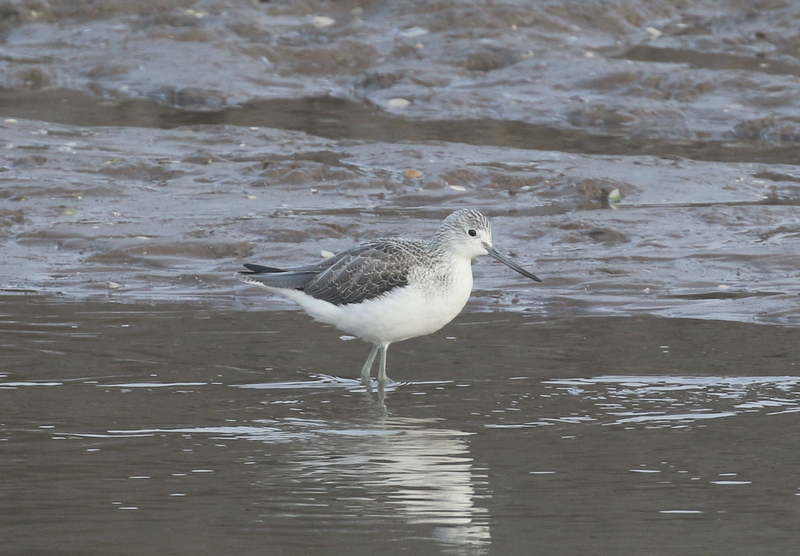 Greenshank – feeding in the channel at Thornham Harbour
Greenshank – feeding in the channel at Thornham Harbour
The fog seemed to lift a little, so we decided to have a go for the geese up at Choseley. As we drove up away from the coast however, we ran into the fog again, which seemed even thicker than before. We could see a few Pink-footed Geese out in the recently harvested sugar beet field, feeding on the discarded tops, but there were a lot fewer geese here than yesterday and we couldn’t see all of them. There was no sign of the Todd’s Canada Goose here today, amongst those Pink-footed Geese that we could see.
The Pink-footed Geese will usually return to the same field to feed for several days, so many had presumably been put off from landing by the fog. While we were there, we could hear calling constantly overhead, and saw several groups fly over in occasional breaks in the sky. Many geese were presumably loafing in other fields nearby, but we just couldn’t see them today. We decided to try something different instead.
As we drove back east along the coast road, the sun finally broke through the fog and it suddenly became bright and clear. Another target for the day was Snow Bunting, so we made a beeline for Salthouse where we knew we could find some. There were some dog walkers going through the area as we walked up, the dogs off the lead and running all over the shingle ridge. Needless to say, there was no sign of the Snow Buntings at first.
Thankfully, after just a couple of minutes, three Snow Buntings flew back in. They perched nervously on the top of the ridge at first, checking to see if the coast was clear, before coming down to a pile of seed which had been put out for them. Great stuff.
 Snow Buntings – coming to seed on the shingle ridge
Snow Buntings – coming to seed on the shingle ridge
The days are short at this time of year, so we wanted to make the most of the remaining light. We headed swiftly round to Blakeney for our final stop. Walking past the duck pond, a lone large gull sitting on the top of a severed tree trunk caught our eye. It is a regularly returning bird and it does not fit any species – among other things, its mantle is too dark grey for Herring Gull and slightly too light for Lesser Black-backed Gull, and its legs an odd fleshy colour. It looks like a Herring Gull x Lesser Black-backed Gull hybrid.
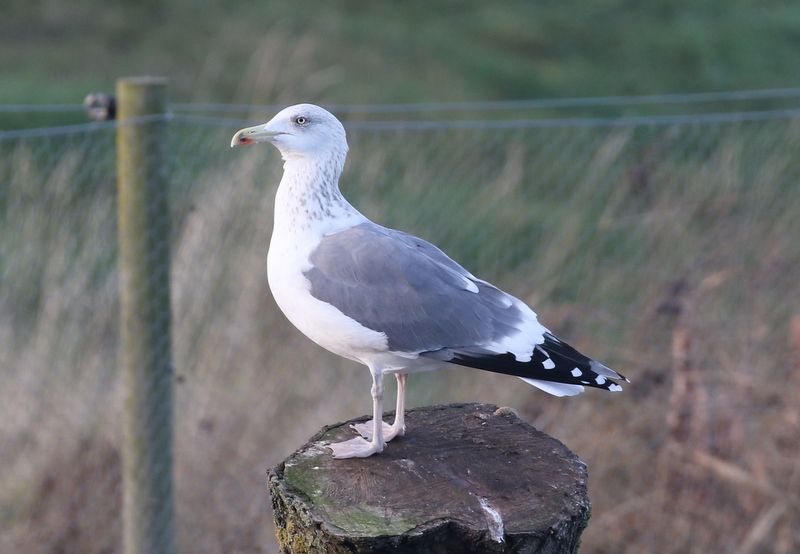 Herring x Lesser Black-backed Gull hybrid – most likely
Herring x Lesser Black-backed Gull hybrid – most likely
As we walked out along the seawall, a Water Rail appeared in one of the channels on the edge of the saltmarsh. It started to walk along in the water at the bottom, until something spooked it and it darted quickly back into cover.
It was very disturbed along the bank this afternoon, with loads of people out for a walk. We did manage to find 12 Barnacle Geese with a flock of Brent Geese out on the Freshes. We could hear Pink-footed Geese further over, towards Cley, and they started to fly off overhead, skein after skein, heading west. We managed to find a handful of Skylarks on the rough ground on the edge of the grazing marsh, but nothing else today.
Unfortunately, we didn’t have long here today. Very quickly, we started to lose the light as the sun dropped. The temperature fell and the mist started to return. We walked back to the car, led by a pair of Stonechats, flying ahead of us along the fence just below the seawall. It was a slightly frustrating day, given the weather, but looking back at what we had seen, we had amassed an impressive total for the day, including most of our main targets. All on one of the shortest days of the year!
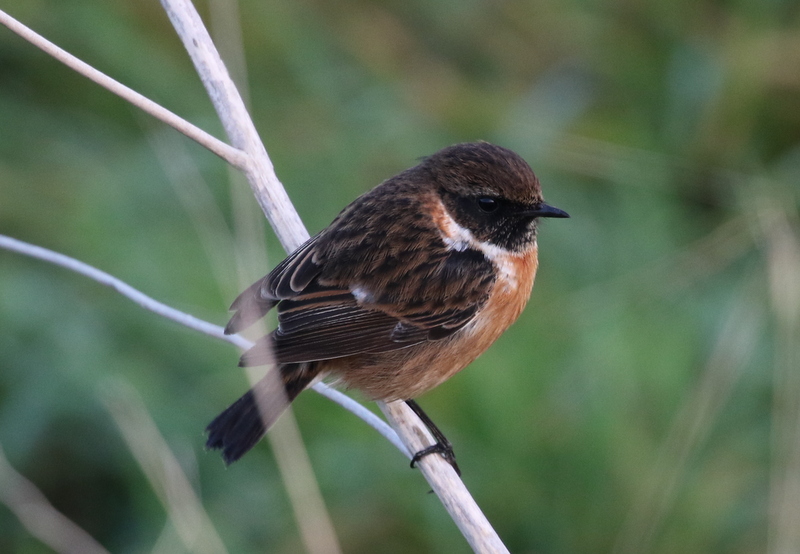 Stonechat – led us back along the seawall
Stonechat – led us back along the seawall
















